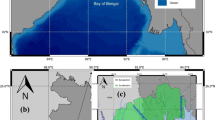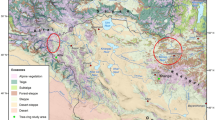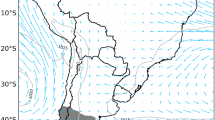Abstract
Ten-day advanced very high resolution radiometer images from 1990 to 2000 were used to examine spatial patterns in the normalized difference vegetation index (NDVI) and their relationships with climatic variables for four contrasting forest types in India. The NDVI signal has been extracted from homogeneous vegetation patches and has been found to be distinct for deciduous and evergreen forest types, although the mixed-deciduous signal was close to the deciduous ones. To examine the decadal response of the satellite-measured vegetation phenology to climate variability, seven different NDVI metrics were calculated using the 11-year NDVI data. Results suggested strong spatial variability in forest NDVI metrics. Among the forest types studied, wet evergreen forests of north-east India had highest mean NDVI (0.692) followed by evergreen forests of the Western Ghats (0.529), mixed deciduous forests (0.519) and finally dry deciduous forests (0.421). The sum of NDVI (SNDVI) and the time-integrated NDVI followed a similar pattern, although the values for mixed deciduous forests were closer to those for evergreen forests of the Western Ghats. Dry deciduous forests had higher values of inter-annual range (RNDVI) and low mean NDVI, also coinciding with a high SD and thus a high coefficient of variation (CV) in NDVI (CVNDVI). SNDVI has been found to be high for wet evergreen forests of north-east India, followed by evergreen forests of the Western Ghats, mixed deciduous forests and dry deciduous forests. Further, the maximum NDVI values of wet evergreen forests of north-east India (0.624) coincided with relatively high annual total precipitation (2,238.9 mm). The time lags had a strong influence in the correlation coefficients between annual total rainfall and NDVI. The correlation coefficients were found to be comparatively high (R2=0.635) for dry deciduous forests than for evergreen forests and mixed deciduous forests, when the precipitation data with a lag of 30 days was correlated against NDVI. Using multiple regression approach models were developed for individual forest types using 16 different climatic indices. A high proportion of the temporal variance (>90%) has been accounted for by three of the precipitation parameters (maximum precipitation, precipitation of the wettest quarter and driest quarter) and two of the temperature parameters (annual mean temperature and temperature of the coldest quarter) for mixed deciduous forests. Similarly, in the case of deciduous forests, four precipitation parameters and three temperature parameters explained nearly 83.6% of the variance. These results suggest differences in the relationship between NDVI and climatic variables based upon the time of growing season, time interval and climatic indices over which they were summed. These results have implications for forest cover map** and monitoring in tropical regions of India.



Similar content being viewed by others
References
Asrar G, Kanemasu ET, Jackson RD, Pinter PJ (1985) Estimation of total aboveground phytomass production using remotely sensed data. Remote Sens Environ 17:211–220
Box EO, Holben BN, Kalb V (1989) Accuracy of the AVHRR vegetation index as a predictor of biomass, primary production and net CO2 flux. Vegetation 80(2):71–89
Champion HG, Seth SK (1968) A revised survey of the forest types of India. Manager of Publications, Government of India, Delhi
Chen X, Xu C, Tan Z (2001) An analysis of relationships among plant community phenology and seasonal metrics of normalized difference vegetation index in the northern part of the monsoon region of China. Int J Biometeorol 45:170–177
Cihlar J, St-Laurent L, Dyer JA (1991) Relation between the normalized difference vegetation index and ecological variables. Remote Sens Environ 35:279–298
Davenport ML, Nicholson SE (1993) On the relation between rainfall and the normalized difference vegetation index for diverse vegetation types in East Africa. Int J Remote Sens 14(12):2369–2389
De Fries R, Hansen M, Townshend J (1995) Global discrimination of land cover types from metrics derived from AVHRR Pathfinder data. Remote Sens Environ 54:209–222
Fang JY, Ohsawa M, Kira T (1996) Vertical vegetation zonation along 30° N latitude in humid East Asia. Vegetation 126:135–149
Farrar TJ, Nicholson SE, Lare AR (1994) The influences of soil type on the relationships between NDVI, rainfall and soil moisture in semiarid Botswana. II. NDVI response to soil moisture. Remote Sens Environ 50:121–133
Gadgil S, Joshi N (1983) Climatic clusters of the Indian region. J Climatol 3:47–63
Gensuo JJ, Howard EHE, Walker DA (2002) Spatial characteristics of AVHRR-NDVI along latitudinal transects in northern Alaska. J Veg Sci 13:315–326
Goward SA (1989) Satellite bioclimatology. J Climatol 7:710–720
Goward SN, Markhan B, Dye DG, Dulaney W, Yang J (1991) Normalized difference vegetation index measurements from the advanced very high resolution radiometer. Remote Sens Environ 35:257–277
Goward SN, Tucker CJ, Dye DG (1985) North American vegetation patterns observed with the NOAA-7 advanced very high-resolution radiometer. Vegetation 64:3–14
Gunnell Y (1997) Relief and climate in South-Asia: the influence of the Western Ghats on the current climate pattern of Peninsular India. Int J Climatol 17:1169–1182
Holm AMcR, Cridland SW, Roderick ML (2003) The use of time-integrated NOAA NDVI data and rainfall to assess landscape degradation in the arid shrubland of Western Australia. Remote Sens Environ 85:145–158
Huete AR, Jackson RD (1987) Suitability of spectral indices for evaluating vegetation characteristics on arid rangelands. Remote Sens Environ 23:213–232
Hunt ER Jr (1994) Relationship between woody biomass and PAR conversion efficiency for estimating net primary production from NDVI. Int J Remote Sens 15:1725–1730
Hutchinson CF (1991) Use of satellite data for famine early warning in sub-Saharan Africa. Int J Remote Sens 12:1405–1421
Iles T (1999) Multiple Regression. In: Fry John C (ed) Biological data analysis: a practical approach. IRL, Oxford University Press, Oxford
Ichii K, Kawabata A, Yamaguchi Y (2002) Global correlation analysis for NDVI and climatic variables and NDVI trends: 1982–1990. Int J Remote Sens 23:18-3873–18-3878
Jensen John R (2000) Remote sensing of the environment: an earth resource perspective, 2nd edn. Prentice-Hall, Upper Saddle River, N.J.
Jolly WM, Running SW (2004) Effects of precipitation and soil water potential on drought deciduous phenology in the Kalahari. Global Change Biol 10:303–308
Juarez RIN, Liu WT (2001) FFT analysis on NDVI annual cycle and climatic regionaility in north-east Brazil. Int J Climatol 21:1803–1820
Justice CO, Holben BN, Gwynne MO (1986) Monitoring East African vegetation using AVHRR data. Int J Remote Sens 1453–1474
Kira T (1991) Forest ecosystems of East and Southeast Asia in a global perspective. Ecol Res 6:185–1991
Kogan FN (1997) Global drought watch from space. Bull Am Meteorol Soc 78:621–636
Malingreau J-P (1986) Global vegetation dynamics: satellite observations over Asia. Int J Remote Sens 7:1121–1146
Malingreau JP, Tucker CJ (1987) Measuring tropical forest disturbances using NOAA satellite data. The case of the Amazon Basin. Proceeding of the IGARSS’87 Symposium, Ann Arbor, Mich., 18–21 May 1987. Institute of Electrical and Electronic Engineers, Piscataway, N.J., pp 443–448
Malo AR, Nicholson SE (1990) A study of rainfall and vegetation dynamics in the African Sahel using normalized difference vegetation index. J Arid Environ 19:1–24
Mather JR, Oshioka G (1968) The role of climate in the distribution of vegetation. Ann Assoc Am Geogr 58:29–41
Menzel A, Fabian P (1999) Growing season extended in Europe. Nature 397:659
Moulin S, Kergoat L, Viovy N (1997) Global-scale assessment of vegetation phenology using NOAA/AVHRR satellite measurements. J Climatol 10:1154–1170
Myers N, Mittermeier RA, Mittermeier CG, da Fonseca GAB, Kent J(2000) Biodiversity hotspots for conservation priorities. Nature 403:853–858
Myneni RB, Tucker CJ, Asrar G, Keeling CD (1998) Inter-annual variations in satellite-sensed vegetation index data from 1981–1991. J Geophys Res 103(D6):6145–6160
Nemani R, Keeling CD, Hashimoto H, Jolly WM, Piper SC, Tucker CJ, Myneni R, Running W (2004) Climate driven increases in global terrestrial net primary production from 1982–1999. Science 1562–1563
Nicholson SE, Farrar TJ (1994) The influence of soil type on the relationships between NDVI, rainfall and soil moisture in semiarid Botswana. I. NDVI response to rainfall. Remote Sens Environ 50:107–120
Nightingale JM, Phinn SR (2003) Assessment of relationships between precipitation and satellite derived by vegetation condition within south Australia. Aust Geogr Stud 41(2):180–195
Norwine J, Gregor DH (1983) Vegetation classification based on AVHRR satellite imagery. Remote Sens Environ 13:69–87
Oindo BO (2002) Patterns of herbivore species richness in Kenya and current ecoclimatic stability. Biodiv Conserv 11:1205–1221
Park JG, Tateishi R (1999) A proposal of the Temporal Window Operation (TWO) method to remove high-frequency noises in AVHRR NDVI time series data. J Jpn Soc Photogr Remote Sens 38:36–47
Parthasarathy AA, Munot Kothawale DR (1995) Monthly and seasonal rainfall series for All-India homogeneous regions and meteorological subdivisions: 1871–1994. Contributions from Indian Institute of Tropical Meteorology, Research Report RR-065, Aug. 1995, Pune 411 008 India
Paruelo JM, Lauenroth WK (1998) Inter annual variability of NDVI and its relationship to climate for North American shrublands and grasslands. J Biogeogr 25:721–733
Pascal JP (1992) Evergreen forests of Western Ghats: structural and functional trends. In: Singh KP, Singh JS (eds) Tropical ecosystems: ecology and management. Wiley, New Delhi, pp 385–408
Potter CS, Brooks V (1998) Global analysis of empirical relations between annual climate and seasonality of NDVI. Int J Remote Sens 19(15):2921–2948
Reed BC, Brown JF, Vanderzee D, Loveland TR, Merchant JW, Ohlen DO (1994) Measuring phenological variability from satellite imagery. J Veg Sci 5(5):703–714
Rundquist BC, Harrington JA Jr, Goodin DG (2000) Mesoscale satellite bioclimatology. Prof Geogr 52:331–344
Schultz P, Halpert M (1995) Global analysis of the relationships among a vegetation index, precipitation and land surface temperature. Int J Remote Sens 16:2755–2777
Schwartz MD, Reed BC (1999) Surface phenology and satellite sensor-derived onset of greenness: an initial comparison. Int J Remote Sens 20:3451–3457
Spanner MA, Pierce LL, Running SW, Peterson DL (1990) The seasonality of AVHRR data of temperate coniferous forests: relationship with leaf area index. Remote Sens Environ 33:97–112
Srivastava SK, Jayaraman V, Nageswara Rao PP, Manikiam B, Chandrasekhar MG (1997) Inter linkages of NOAA/AVHRR derived integrated NDVI to seasonal precipitation and transpiration in dry land tropics. Int J Remote Sens 18(14):2931–2952
Suzuki R, Tanaka S, Yasunari T (2000) Relationships between meridonal profiles of satellite-derived vegetation index (NDVI) and climate over Siberia. Int J Climatol 20:955–967
Tateishi R, Ebata M (2004) Analysis of phenological change patterns using 1982–2000 advanced very high resolution radiometer (AVHRR) data. Int J Remote Sens 25(4):2287–2300
Tateishi R, Kajiwara K (1992) Global land cover monitoring by AVHRR NDVI data. Earth Environ 7:4–14
Townshend JRG, Justice CO (1986) Analysis of the dynamics of African vegetation using the normalized difference vegetation Index. Int J Remote Sens 7:1435–1445
Tucker CJ, Sellers PJ (1986) Satellite remote sensing of primary production. Int J Remote Sens 7:1395–1416
Wang JM, Rich PM, Price KP (2003) Temporal response of NDVI to precipitation and temperature in the central Great Plains, USA. Int J Remote Sens 24(11):2345–2364
White MA, Thornton PE, Running SW (1997) A continental phenology model for monitoring vegetation responses to inter annual climatic variability. Global Biogeochem Cycles 11:217–234
Wulder MA, LeDrew EF, Franklin SE, Lavigne MB (1998) Aerial image texture information in the estimation of northern deciduous and mixed wood forest leaf area index (LAI). Remote Sens Environ 64:64–76
Zhou L, Kaufmann RK, Tian Y, Myneni RB, Tucker CJ (2004) Relation between intern annual variations in satellite measures of northern forest greenness and climate between 1982–1999. J Geophys Res 108(D1):40004. 3-1–16
Acknowledgements
The authors are grateful to Prof. Tateishi, CERES, Chiba University, Japan for providing the datasets. Thanks are also due to Prof. T. Rajagopal, Osmania University India, for useful suggestions relating to phenological characteristics of the vegetation.
Author information
Authors and Affiliations
Corresponding author
Rights and permissions
About this article
Cite this article
Prasad, V.K., Anuradha, E. & Badarinath, K.V.S. Climatic controls of vegetation vigor in four contrasting forest types of India—evaluation from National Oceanic and Atmospheric Administration’s Advanced Very High Resolution Radiometer datasets (1990–2000) . Int J Biometeorol 50, 6–16 (2005). https://doi.org/10.1007/s00484-005-0268-0
Received:
Revised:
Accepted:
Published:
Issue Date:
DOI: https://doi.org/10.1007/s00484-005-0268-0




